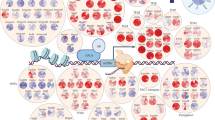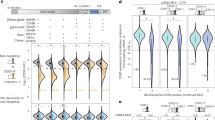Abstract
Most human genes produce multiple splicing isoforms with distinct functions. To systematically understand splicing regulation, we conducted an unbiased screen and identified >100 intronic splicing enhancers (ISEs), clustered by sequence similarity. All ISEs functioned in multiple cell types and in heterologous introns, and patterns of distribution and conservation across pre-mRNA regions were similar to those of exonic splicing silencers. Consistently, all ISEs inhibited use of splice sites from exons. Putative trans-factors of each ISE group were identified and validated. Five distinct groups were recognized by hnRNP H and hnRNP F, whose C-terminal domains were sufficient to render context-dependent activities of ISEs. The sixth group was controlled by factors that either activate or suppress splicing. We provide a comprehensive picture of general ISE activities and suggest new models of how single elements can function oppositely, depending on locations and binding factors.
This is a preview of subscription content, access via your institution
Access options
Subscribe to this journal
Receive 12 print issues and online access
$189.00 per year
only $15.75 per issue
Buy this article
- Purchase on Springer Link
- Instant access to full article PDF
Prices may be subject to local taxes which are calculated during checkout






Similar content being viewed by others
References
Wang, E.T. et al. Alternative isoform regulation in human tissue transcriptomes. Nature 456, 470–476 (2008).
Pan, Q., Shai, O., Lee, L.J., Frey, B.J. & Blencowe, B.J. Deep surveying of alternative splicing complexity in the human transcriptome by high-throughput sequencing. Nat. Genet. 40, 1413–1415 (2008).
Castle, J.C. et al. Expression of 24,426 human alternative splicing events and predicted cis regulation in 48 tissues and cell lines. Nat. Genet. 40, 1416–1425 (2008).
Black, D.L. Mechanisms of alternative pre-messenger RNA splicing. Annu. Rev. Biochem. 72, 291–336 (2003).
Matlin, A.J., Clark, F. & Smith, C.W. Understanding alternative splicing: towards a cellular code. Nat. Rev. Mol. Cell Biol. 6, 386–398 (2005).
Wang, Z. & Burge, C.B. Splicing regulation: from a parts list of regulatory elements to an integrated splicing code. RNA 14, 802–813 (2008).
Nilsen, T.W. & Graveley, B.R. Expansion of the eukaryotic proteome by alternative splicing. Nature 463, 457–463 (2010).
Barash, Y. et al. Deciphering the splicing code. Nature 465, 53–59 (2010).
Tian, H. & Kole, R. Selection of novel exon recognition elements from a pool of random sequences. Mol. Cell. Biol. 15, 6291–6298 (1995).
Liu, H.X., Zhang, M. & Krainer, A.R. Identification of functional exonic splicing enhancer motifs recognized by individual SR proteins. Genes Dev. 12, 1998–2012 (1998).
Fairbrother, W.G., Yeh, R.F., Sharp, P.A. & Burge, C.B. Predictive identification of exonic splicing enhancers in human genes. Science 297, 1007–1013 (2002).
Zhang, X.H. & Chasin, L.A. Computational definition of sequence motifs governing constitutive exon splicing. Genes Dev. 18, 1241–1250 (2004).
Wang, Z. et al. Systematic identification and analysis of exonic splicing silencers. Cell 119, 831–845 (2004).
Stadler, M.B. et al. Inference of splicing regulatory activities by sequence neighborhood analysis. PLoS Genet. 2, e191 (2006).
Goren, A. et al. Comparative analysis identifies exonic splicing regulatory sequences–the complex definition of enhancers and silencers. Mol. Cell 22, 769–781 (2006).
Yu, Y. et al. Dynamic regulation of alternative splicing by silencers that modulate 5′ splice site competition. Cell 135, 1224–1236 (2008).
Ke, S. et al. Quantitative evaluation of all hexamers as exonic splicing elements. Genome Res. 21, 1360–1374 (2011).
Fairbrother, W.G., Holste, D., Burge, C.B. & Sharp, P.A. Single nucleotide polymorphism-based validation of exonic splicing enhancers. PLoS Biol. 2, E268 (2004).
Xiao, X., Wang, Z., Jang, M. & Burge, C.B. Coevolutionary networks of splicing cis-regulatory elements. Proc. Natl. Acad. Sci. USA 104, 18583–18588 (2007).
Lam, B.J. & Hertel, K.J. A general role for splicing enhancers in exon definition. RNA 8, 1233–1241 (2002).
Ke, S., Zhang, X.H. & Chasin, L.A. Positive selection acting on splicing motifs reflects compensatory evolution. Genome Res. 18, 533–543 (2008).
Wang, Z., Xiao, X., Van Nostrand, E. & Burge, C.B. General and specific functions of exonic splicing silencers in splicing control. Mol. Cell 23, 61–70 (2006).
Yeo, G.W., Van Nostrand, E.L. & Liang, T.Y. Discovery and analysis of evolutionarily conserved intronic splicing regulatory elements. PLoS Genet. 3, e85 (2007).
Voelker, R.B. & Berglund, J.A. A comprehensive computational characterization of conserved mammalian intronic sequences reveals conserved motifs associated with constitutive and alternative splicing. Genome Res. 17, 1023–1033 (2007).
Yeo, G.W., Van Nostrand, E., Holste, D., Poggio, T. & Burge, C.B. Identification and analysis of alternative splicing events conserved in human and mouse. Proc. Natl. Acad. Sci. USA 102, 2850–2855 (2005).
Chou, M.Y., Rooke, N., Turck, C.W. & Black, D.L. hnRNP H is a component of a splicing enhancer complex that activates a c-src alternative exon in neuronal cells. Mol. Cell. Biol. 19, 69–77 (1999).
McCullough, A.J. & Berget, S.M. G triplets located throughout a class of small vertebrate introns enforce intron borders and regulate splice site selection. Mol. Cell. Biol. 17, 4562–4571 (1997).
Wang, E., Mueller, W.F., Hertel, K.J. & Cambi, F.G. Run-mediated recognition of proteolipid protein and DM20 5′ splice sites by U1 small nuclear RNA is regulated by context and proximity to the splice site. J. Biol. Chem. 286, 4059–4071 (2011).
Wang, E., Dimova, N. & Cambi, F. PLP/DM20 ratio is regulated by hnRNPH and F and a novel G-rich enhancer in oligodendrocytes. Nucleic Acids Res. 35, 4164–4178 (2007).
Xiao, X. et al. Splice site strength-dependent activity and genetic buffering by poly-G runs. Nat. Struct. Mol. Biol. 16, 1094–1100 (2009).
Ule, J. et al. CLIP identifies Nova-regulated RNA networks in the brain. Science 302, 1212–1215 (2003).
Brudno, M. et al. Computational analysis of candidate intron regulatory elements for tissue-specific alternative pre-mRNA splicing. Nucleic Acids Res. 29, 2338–2348 (2001).
Underwood, J.G., Boutz, P.L., Dougherty, J.D., Stoilov, P. & Black, D.L. Homologues of the Caenorhabditis elegans Fox-1 protein are neuronal splicing regulators in mammals. Mol. Cell. Biol. 25, 10005–10016 (2005).
Blencowe, B.J. Alternative splicing: new insights from global analyses. Cell 126, 37–47 (2006).
Agrawal, R., Imielinski, T. & Swami, A. Mining association rules between sets of items in large databases. in Proc.1993 ACM-SIGMOD Int. Conf. on Management of Data 207–216 (1993).
Dominski, Z., Yang, X.C., Kaygun, H., Dadlez, M. & Marzluff, W.F. A 3′ exonuclease that specifically interacts with the 3′ end of histone mRNA. Mol. Cell 12, 295–305 (2003).
Huelga, S.C. et al. Integrative genome-wide analysis reveals cooperative regulation of alternative splicing by hnRNP proteins. Cell Rep 1, 167–178 (2012).
Pastor, T. & Pagani, F. Interaction of hnRNPA1/A2 and DAZAP1 with an Alu-derived intronic splicing enhancer regulates ATM aberrant splicing. PLoS ONE 6, e23349 (2011).
Lai, M.C., Kuo, H.W., Chang, W.C. & Tarn, W.Y. A novel splicing regulator shares a nuclear import pathway with SR proteins. EMBO J. 22, 1359–1369 (2003).
Chen, C.D., Kobayashi, R. & Helfman, D.M. Binding of hnRNP H to an exonic splicing silencer is involved in the regulation of alternative splicing of the rat beta-tropomyosin gene. Genes Dev. 13, 593–606 (1999).
Dominguez, C., Fisette, J.F., Chabot, B. & Allain, F.H. Structural basis of G-tract recognition and encaging by hnRNP F quasi-RRMs. Nat. Struct. Mol. Biol. 17, 853–861 (2010).
Graveley, B.R. & Maniatis, T. Arginine/serine-rich domains of SR proteins can function as activators of pre-mRNA splicing. Mol. Cell 1, 765–771 (1998).
Del Gatto-Konczak, F., Olive, M., Gesnel, M.C. & Breathnach, R. hnRNP A1 recruited to an exon in vivo can function as an exon splicing silencer. Mol. Cell. Biol. 19, 251–260 (1999).
Wang, Y., Cheong, C.G., Hall, T.M. & Wang, Z. Engineering splicing factors with designed specificities. Nat. Methods 6, 825–830 (2009).
Goina, E., Skoko, N. & Pagani, F. Binding of DAZAP1 and hnRNPA1/A2 to an exonic splicing silencer in a natural BRCA1 exon 18 mutant. Mol. Cell. Biol. 28, 3850–3860 (2008).
Kar, A., Havlioglu, N., Tarn, W.Y. & Wu, J.Y. RBM4 interacts with an intronic element and stimulates tau exon 10 inclusion. J. Biol. Chem. 281, 24479–24488 (2006).
Markus, M.A. et al. WT1 interacts with the splicing protein RBM4 and regulates its ability to modulate alternative splicing in vivo. Exp. Cell Res. 312, 3379–3388 (2006).
Lin, J.C. & Tarn, W.Y. Exon selection in alpha-tropomyosin mRNA is regulated by the antagonistic action of RBM4 and PTB. Mol. Cell. Biol. 25, 10111–10121 (2005).
Culler, S.J., Hoff, K.G., Voelker, R.B., Berglund, J.A. & Smolke, C.D. Functional selection and systematic analysis of intronic splicing elements identifies active sequence motifs and associated splicing factors. Nucleic Acids Res. 38, 5152–5165 (2010).
Cook, K.B., Kazan, H., Zuberi, K., Morris, Q. & Hughes, T.R. RBPDB: a database of RNA-binding specificities. Nucleic Acids Res. 39, D301–D308 (2011).
Acknowledgements
We thank J. Hui from the Shanghai Institute of Biological Science, Shanghai, China and W.-Y. Tarn from the Institute of Biomedical Sciences, Academia Sinica, Taipei, China for providing the expression constructs and B. Marzluff and C. Burge for critical reading of manuscripts. We thank. Z. Dominski for helping in RNA affinity purifications. This work is supported by an American Heart Association grant (0865329E) and US National Institutes of Health grant (R01CA158283) to Z.W.
Author information
Authors and Affiliations
Contributions
Y.W. and Z.W. designed the research and performed the experiments. M.M. and X.X. developed computational methods to analyze the data. Y.W. and Z.W. wrote the paper.
Corresponding author
Ethics declarations
Competing interests
The authors declare no competing financial interests.
Supplementary information
Supplementary Text and Figures
Supplementary Figures 1–6, Supplementary Tables 1–7 and Supplementary Note (PDF 4849 kb)
Rights and permissions
About this article
Cite this article
Wang, Y., Ma, M., Xiao, X. et al. Intronic splicing enhancers, cognate splicing factors and context-dependent regulation rules. Nat Struct Mol Biol 19, 1044–1052 (2012). https://doi.org/10.1038/nsmb.2377
Received:
Accepted:
Published:
Issue Date:
DOI: https://doi.org/10.1038/nsmb.2377
This article is cited by
-
Role of epithelial splicing regulatory protein 1 in cancer progression
Cancer Cell International (2023)
-
Mechanism and modeling of human disease-associated near-exon intronic variants that perturb RNA splicing
Nature Structural & Molecular Biology (2022)
-
Pervasive translation of circular RNAs driven by short IRES-like elements
Nature Communications (2022)
-
Clinical implementation of RNA sequencing for Mendelian disease diagnostics
Genome Medicine (2022)
-
Regulatory roles and mechanisms of alternative RNA splicing in adipogenesis and human metabolic health
Cell & Bioscience (2021)



